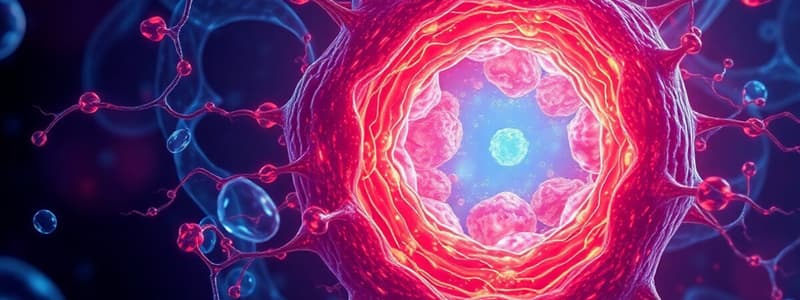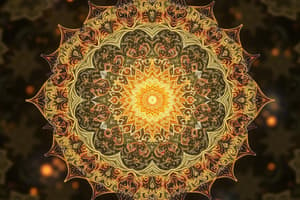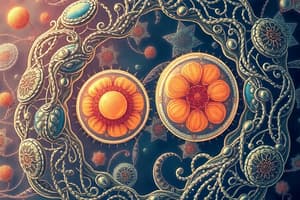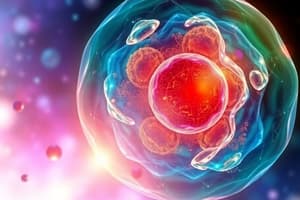Podcast
Questions and Answers
Which of these statements correctly describes why cells are small?
Which of these statements correctly describes why cells are small?
- Small cells are more easily damaged by external forces, which prevents them from becoming too large.
- Small cells contain less DNA, making it easier to replicate and divide.
- Small cells have a higher surface area to volume ratio, allowing for efficient nutrient and waste exchange. (correct)
- Small cells have a greater number of mitochondria, increasing their energy production capacity, despite their size.
Imagine two species that have evolved from a common ancestor. One species lives in a forest with plenty of short, shallow flowers, while the other lives on a plain with tall, deep flowers. What type of evolutionary pressure might have driven the development of longer beaks in the species that lives on the plain?
Imagine two species that have evolved from a common ancestor. One species lives in a forest with plenty of short, shallow flowers, while the other lives on a plain with tall, deep flowers. What type of evolutionary pressure might have driven the development of longer beaks in the species that lives on the plain?
- Natural selection, where longer beaks provide an advantage for accessing deep nectar. (correct)
- Reproductive isolation, as their beaks are different and they can no longer mate.
- Mutations, which randomly occurred and resulted in longer beaks in one species.
- Geographic isolation, as the two species are separated by a barrier.
Which of the following statements accurately describes a key difference between Archaea and Bacteria?
Which of the following statements accurately describes a key difference between Archaea and Bacteria?
- Archaea have a nucleus, while Bacteria lack a nucleus.
- Archaea have unique cell walls, while Bacteria have more typical cell walls. (correct)
- Archaea are multicellular, while Bacteria are single-celled.
- Archaea are prokaryotes, while Bacteria are eukaryotes.
Which of the following is NOT a characteristic that distinguishes plants from animals?
Which of the following is NOT a characteristic that distinguishes plants from animals?
A scientist discovers a new organism that lives in a harsh, acidic environment. Based on its cell wall structure, the scientist hypothesizes that it is related to Archaea. What specific characteristic of the organism would support the scientist's hypothesis?
A scientist discovers a new organism that lives in a harsh, acidic environment. Based on its cell wall structure, the scientist hypothesizes that it is related to Archaea. What specific characteristic of the organism would support the scientist's hypothesis?
Flashcards
What is mitosis?
What is mitosis?
The process of cell division where a single cell divides into two identical daughter cells, ensuring each new cell receives a complete copy of the parent cell's DNA.
What is the cell theory?
What is the cell theory?
The theory that all living things are composed of cells, cells are the fundamental unit of life, and all cells arise from pre-existing cells.
What is evolution?
What is evolution?
The process of change over time in the characteristics of a species, driven by natural selection.
What is natural selection?
What is natural selection?
Signup and view all the flashcards
What is the cell membrane?
What is the cell membrane?
Signup and view all the flashcards
Study Notes
Cell Size and Function
- Cells are small because their volume increases faster than their surface area.
- Small cells are more efficient in moving nutrients and waste products.
- Limits to cell size: the ratio of surface area to volume, the efficiency of moving materials, and DNA efficiency.
The Cell Cycle
- S Phase: DNA is duplicated.
- Mitosis: The nucleus divides.
- Cytokinesis: The cell splits into two daughter cells.
Mitosis
- Ensures that daughter cells have the same DNA as the parent cell.
Cell Theory
- All living things are made of cells.
- Cells are the basic unit of life.
- All new cells come from pre-existing cells.
Plant vs. Animal Cells
- Plant cells have cell walls and chloroplasts.
- Both plant and animal cells have cell membranes and mitochondria.
Cell Membrane
- Composed of fats (phospholipids) with water-attracting heads and water-repelling tails.
- Controls what enters and exits the cell.
Protein Production
- Ribosomes create proteins.
- The Golgi apparatus packages and sorts proteins.
Evolution
- Species change over time due to natural selection.
- Example: Birds with longer beaks may thrive if food is deep within trees.
Speciation
- Geographic isolation: A physical barrier separates a population.
- Reproductive isolation: Populations stop interbreeding.
Mutations
- DNA changes.
- Drive evolution by creating differences.
Darwin's Observations
- Island species are similar to mainland species but adapted to new environments.
Classification
- Scientific names are used (e.g., Felis catus for a cat).
- Archaea and bacteria are both single-celled, but archaea have distinct cell walls.
Characteristics of Life
- Composed of cells.
- Respond to the environment.
- Grow, reproduce, use energy.
Kingdom Differences
- Animals: Move, don't produce their own food.
- Plants: Stay in one place, make their own food using sunlight.
Studying That Suits You
Use AI to generate personalized quizzes and flashcards to suit your learning preferences.




